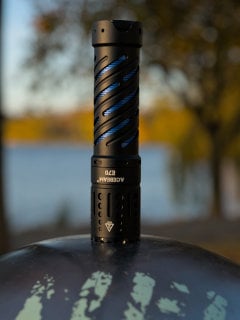Hi there, I’m glad to see a flashlight community here! I lost my trusty stylus on a call and I’m hoping that y’all could recommend a worthy replacement. I would happily purchase the same but I’m wondering if there are some other options that I might be missing out on.
Rugged and easy operation are key requirements. If it’s very bright it would be handy to have a low intensity setting for checking for pupil dilation on a subject.


I used to carry a Stylus Pro and loved it… until I fell down the rabbit hole and discovered MUCH better flashlights.
My first was the Rider RX. Rugged, simple to learn (though with problems… I’ll get to that), and the lowest most was 12 lumens with the included 14500. Still more than I like for pupil exams having worked Optometry so long, but low enough to get the job done. Just hold it back a little further. It also has great CRI, which helps with a lot in medical settings. Then I found better. Much better.
Everybody need a TS10.
There’s a bit of a learning curve, but once you get past that, it’s simple. The hard part is just that it’s different. The lowest setting can be so low that it’s useless for pupil exams; that’s how dim it can get. But you can change that. The brightest it can get is probably brighter than you need. Again, that can also be changed. Going from pupil exams to over ten times what your lost Stylus Pro can do, and in something smaller.
While many are intimidated by the diagram that shows the full capabilities of Anduril, in actual use in the really real world, it’s a lot like most other flashlights. A simple click will get it to the last-used brightness you had it. A double-click while on will make it as bright as it can get. Those are near-universal in high-end flashlights. Holding the button will start dim and make it brighter; many other lights have you hold from Off for low levels. The main difference with Anduril is that, by default and with no programming, it raises brightness smoothly when you hold the button; just release the button when it’s at the level you want. If you overshoot while raising brightness, just let off briefly and then hold the button again to dim it. If you need to dim it it after not adjusting it upwards, press-release-press-and-hold (2H). Like the Rider RX, it has excellent color rendering to aid with pupil exams and wound inspections. It’s also at least as rugged as your Stylus Pro, and slightly cheaper. Once you get used to it, it’s pretty easy. And my wife got used to it in under a minute with no instruction at all; possibly because she never saw the manual and wasn’t intimidated.
The downside is that it cannot accept regular AA batteries, and lacks onboard charging. That means you need an external charger and spare batteries… not unlike the radio you probably carry if you do SAR. There are some low-priced Xtar chargers, and spare cells are cheap, though my experience is that the TS10 requires recharging less than half as often as my Stylus Pro needed batter swaps; one charge on my TS10 lasted longer than 4 AA’s in my Stylus Pro or 2 AA’s in my Rider RX unless I cranked it FAR beyond what either light is capable of.
If you want a light that can survive being drop-kicked repeatedly, allows you to get a good look at wounds, and can go from “too dim for pupil exams” to “DAMN, that’s bright!”, for less than the cost of a Stylus Pro, then grab yourself a 4000K TS10.